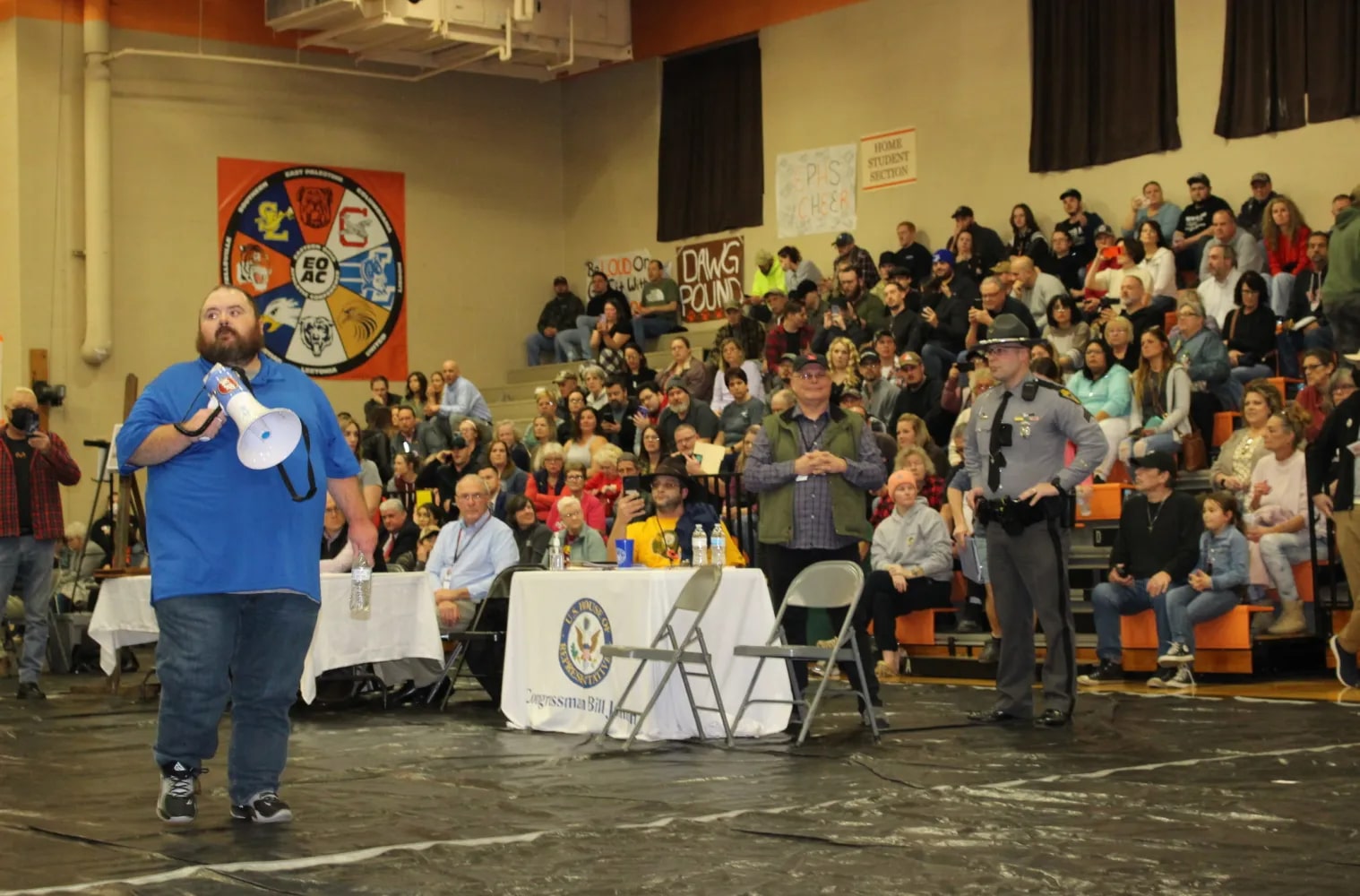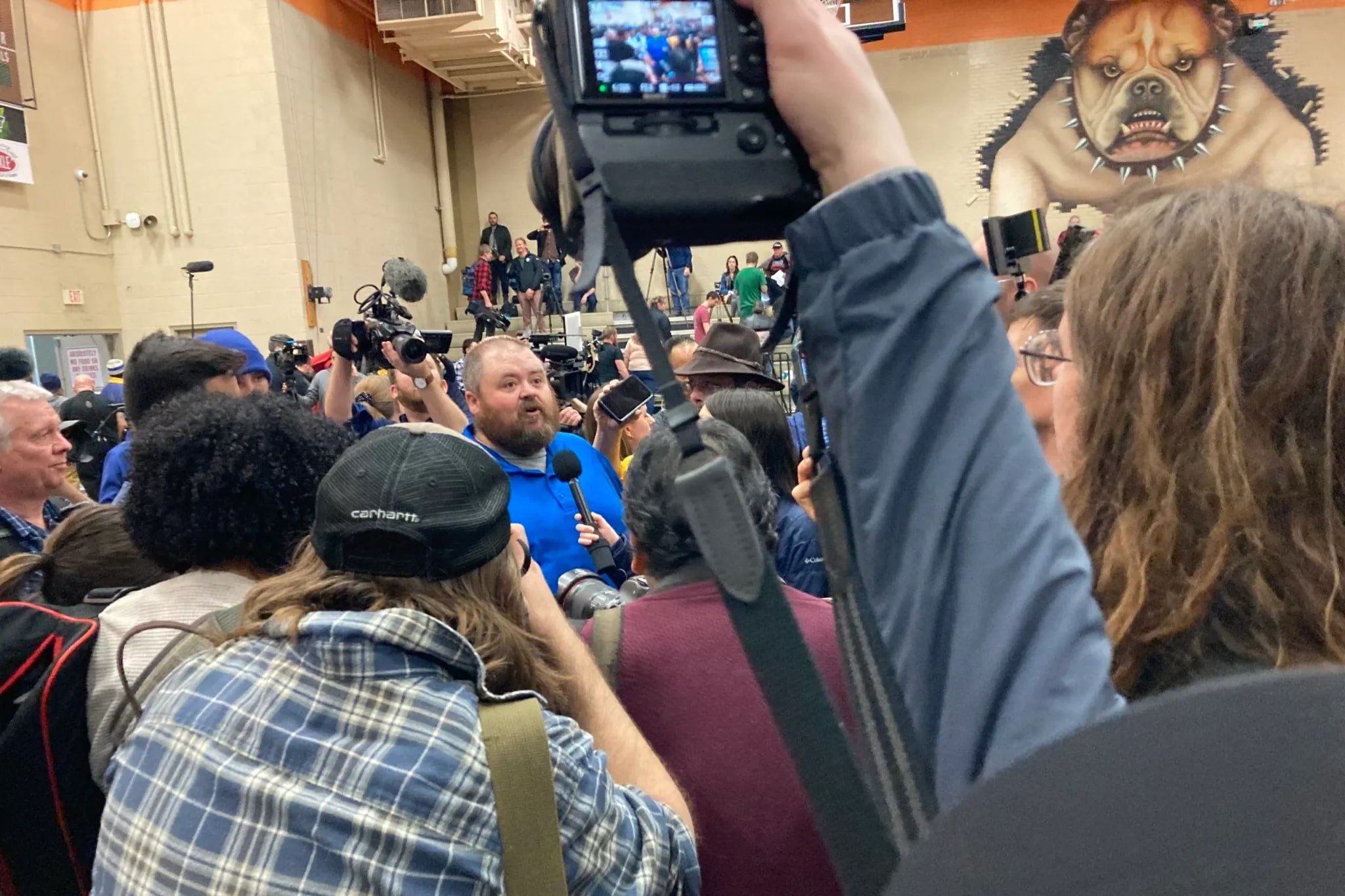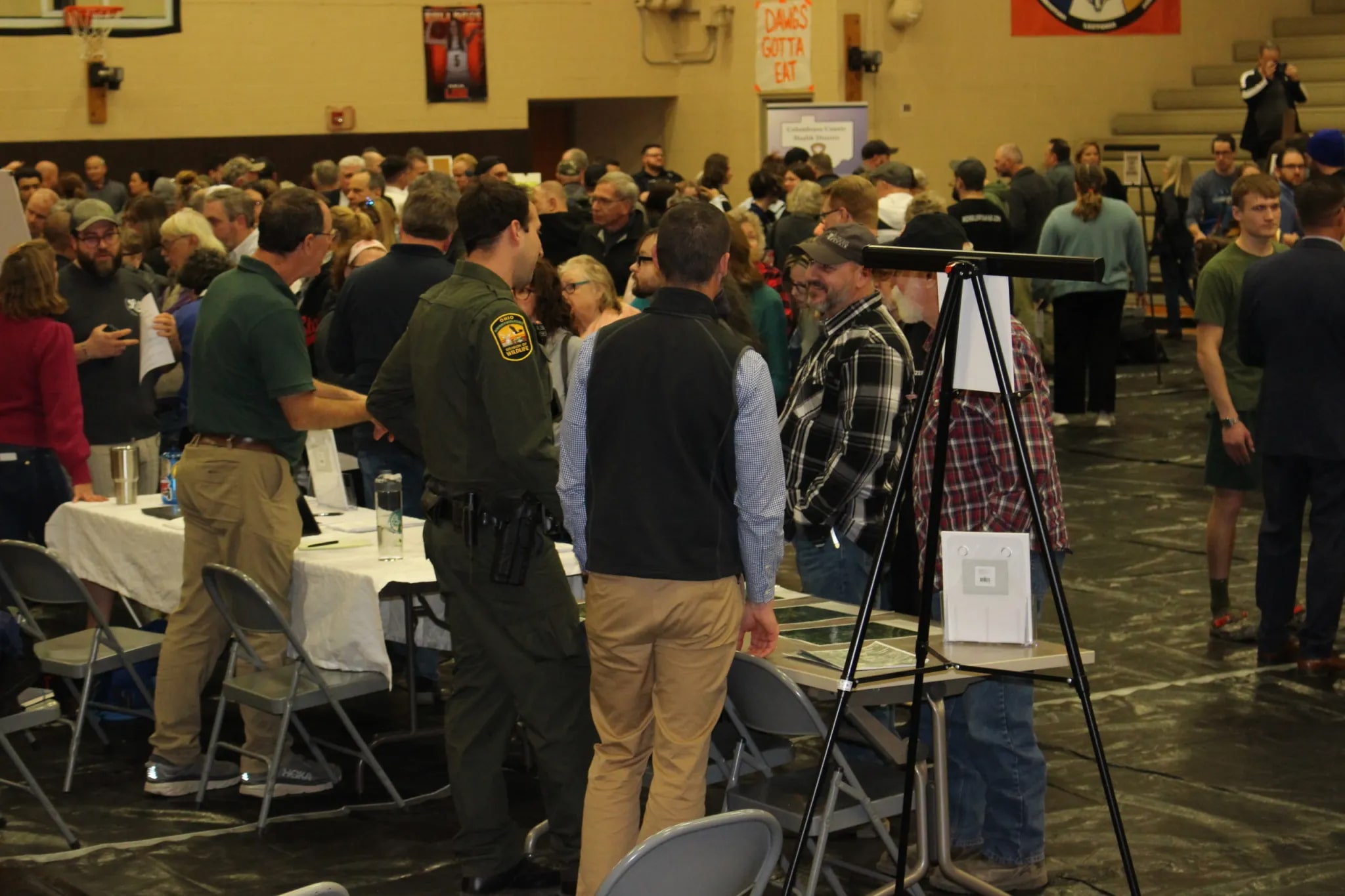Ohio Residents Want Answers About Risks Of Train Derailment
9:24 minutes

This article is part of The State of Science, a series featuring science stories from public radio stations across the United States. This story, by Julie Grant was originally published by The Allegheny Front.
Hundreds of people packed the high school gymnasium in East Palestine, Ohio, Wednesday evening, trying to get some answers about whether they were safe in their homes after an explosion and the release of numerous toxic chemicals following the train derailment two weeks ago.
What started as an open house with tables set up around the floor for the US EPA, the Ohio EPA, the state Division of Wildlife, and the county health department to answer individual questions morphed into a town hall meeting.
Residents sat in bleachers and yelled their questions to the officials. Many were angry, largely because Norfolk Southern, the rail operator, did not show up to the meeting.

East Palestine Mayor Trent Conaway, surrounded by the media, said the company feared for the safety of its employees because there was so much anger against them. Conaway said people keep blaming him for this horrible incident, and it’s not his fault:
“Yes, harmful chemicals went in the air,” he said. “I’m truly sorry, but that is the only option we had. If we didn’t do that, then they were going to blow up. We were going throw shrapnel all across this town.”
Conaway said he just wants people to feel safe.
“People keep forgetting, I’m a local politician,” he said. “I live in this town. I don’t live somewhere else. I live two blocks from the train tracks. I’m concerned just like everybody else.”

Many people are worried about the air quality. Regulators and Norfolk Southern have been telling the community that the air is safe, yet there’s a strong odor in the air. A young boy asked if it was safe to play outside when there was such a strong smell.
James Justice of the US EPA responded, blaming the chemical butyl acrylate for the smell. He said the chemical can linger for a long time without causing any health effects. It has also been blamed for the death of 3,500 fish in nearby waterways.
People had questions about the monitoring of their drinking water wells and asked if they could wash their dishes and clothing, and bathe in their water. Earlier in the day, Ohio’s governor Mike DeWine notified residents that the city water was safe for use, according to the latest tests.
While many stayed until the end of the meeting, which was more than two hours long, most people left midway through, like Rebecca Dilts.
“I feel like they’re just saying the same stuff, and they’re not really giving any new information to anybody,” she said.
She wanted to hear from Norfolk Southern about what to expect next and wanted more information about water safety, soil testing, and air quality.
Dilts’ family lives 1.8 miles from the site and returned home the evening the evacuation order was lifted. The next morning, her daughter woke up with what she called chemical pink eye.
“Both of her eyes were swollen, and then they were bloodshot, and they were swollen all the way down to pass her cheeks,” she said. “Whenever I took her to the doctor and explained the situation, she actually had to call another pediatric eye doctor because she wasn’t sure how to treat it.”
Another parent, Jamie Erbin, hasn’t returned to her home, which is within the one-mile evacuation zone.
“Me and my kids have been living out of a cabin,” Erbin said. “I’m in the one-mile radius, and I refuse to bring them back because I know there’s something wrong. You know, it’s costing me money I can’t afford. I don’t have the money to do this, but I’m doing it.”
Erbin says she doesn’t trust the air test results because some of it has been done by a Norfolk Southern contractor. She says her five-year-old has developed an eczema-type rash that he’s never had before. She blamed the pollution but was told it was because he had gone swimming.
“I’m moving. I literally have to move,” she said. “I have to wait to get the funds together and relocate because I’m not doing this to my kids.”
Many people questioned why the federal government had not gotten involved.
On Thursday, EPA administrator Michael Regan visited the town. Ohio Governor Mike DeWine, who spoke with the White House, said he sent a letter to the CDC to “immediately” send medical experts to “evaluate and counsel community members who have questions and/or are experiencing symptoms.”
The president of Norfolk Southern, Alan Shaw, wrote a letter to East Palestine, promising the company would not walk away from this situation. Meanwhile, a number of citizens and businesses have filed lawsuits against the company.
Kara Holsopple contributed to the reporting.
Invest in quality science journalism by making a donation to Science Friday.
Julie Grant is a senior reporter at The Allegheny Front, in Pittsburgh, Pennsylvania.
IRA FLATOW: This is Science Friday. I’m Ira Flatow. And now it’s time to check in on the state of science.
SPEAKER 1: This is KERA News.
SPEAKER 2: For WWNO–
SPEAKER 3: St. Louis Public Radio–
SPEAKER 4: [INAUDIBLE]
SPEAKER 5: Iowa Public Radio News.
IRA FLATOW: Local science stories of national significance– it’s been two weeks since a Norfolk Southern train derailed in East Palestine, Ohio. That train was carrying hazardous chemicals. People want answers about the effects this will have on this rural community’s air and water. Their frustrations were vocalized at a community event on Wednesday.
My next guest was there, Julie Grant, managing editor and reporter for The Allegheny Front, based in Pittsburgh, Pa. Welcome to Science Friday.
JULIE GRANT: Thank you.
IRA FLATOW: Before we get into this meeting, can you give us a little bit of a reminder of the details of this derailment?
JULIE GRANT: Sure. On Friday night, about two weeks ago, 50 cars of a Norfolk Southern freight train was on its way from Illinois, derailed near a small town in Ohio, East Palestine, as you said, near the Pennsylvania border. The mile-and-a-half-long train was carrying at least 10 cars of chemicals. So there was an explosion and fires.
That weekend there was a lot of confusion and stress in that community. Within a day or so, the Red Cross had set up temporary shelter space in the local school. And the company set up an assistance center for the community, for people who live nearby, to get help paying for hotels because people wanted to get out of the area immediately. At least some people did.
IRA FLATOW: Mhm. Mhm. These chemicals, were they particularly hazardous or have health threats to the population?
JULIE GRANT: Yeah, I mean, when the crash occurred, we found out first about two toxic chemicals, butyl acrylate, and especially they were talking about vinyl chloride. Exposure to vinyl chloride is known to increase the risk of developing cancer. Since then, information has come out about other chemicals on board, including ethylhexyl acrylate. That can cause headaches, nausea, respiratory problems in people exposed to it, also isobutylene, which can make people dizzy and drowsy, and then another chemical that is known to irritate eyes, skin, and the respiratory tract.
IRA FLATOW: Wow. Wow. And then there was a controlled explosion to try to get rid of the chemicals?
JULIE GRANT: Yeah, so this has been pretty controversial in this community. A few days after the derailment, Norfolk Southern and regulators said that five of the cars contain that vinyl chloride we mentioned and that inside at least one of those cars temperatures were rising. So the Ohio governor, Mike DeWine, said that they were worried this was going to create a catastrophic explosion that would send shrapnel throughout this community and creating grave danger for people there. So he demanded that residents within a one-to-two-mile radius in this evacuation zone get out of there immediately or face arrest.
This, the company said and the regulators said, was an effort to gain control. They cut small holes in the train cars to slowly release the chemicals into a trench. And then they burned it off. With this, the effort was to dissipate this into the air.
That led to an explosion. And it sent more toxic fumes throughout this community, which, of course, infuriated many people. But officials said that they still thought this was the best option, given the potential for an unplanned explosion.
IRA FLATOW: Mhm. And these infuriated people got together in a public meeting Wednesday night, almost two weeks after the derailment. You were there. Who else was there?
JULIE GRANT: Look, in the early days, this was only local media. I will say that at this meeting at the local high school, I mean, there was at least 50, maybe 100 reporters there. And also hundreds of residents poured into the high school gym in East Palestine. They were trying to get some answers about whether they’re safe in their homes.
So officials from US EPA, Ohio EPA, the State Division of Wildlife, the County Health Department were all there. There was a lot of emotion in this room, in large part because the company, Norfolk Southern, the rail operator, did not show up. They did let people a little bit beforehand that they were not going to be there.
The East Palestine mayor, Trent Conway, said the company feared for the safety of its employees because people were so angry. Conway said people keep blaming him for this terrible accident. And he kept saying, this isn’t his fault.
TRENT CONWAY: Yes, harmful chemicals went in the air. I am truly sorry, but that is the only option we had. If we didn’t do that, then they were going to blow up and we were going to throw shrapnel all across this town.
People keep forgetting, I’m a local politician. I live in this town. I don’t live somewhere else. I live in East Palestine. I live two blocks from the train tracks.
IRA FLATOW: Hmm. And the people are not feeling safe, would it be safe to say?
JULIE GRANT: I would say a lot of people are not. They have a lot of concerns, mostly how this is going to impact their health. I talked with one mother, Rebecca Dilts. She had a young child with her. She says they live 1.8 miles from the site. They returned home the evening after that evacuation order was lifted. And the next morning, her daughter woke up with what she called chemical pinkeye.
REBECCA DILTS: Both of her eyes were swollen. And then she had– they were bloodshot. And they were swollen all the way down to pass through cheeks. And then whenever I took her to the doctor and explained the situation, she actually had to call another pediatric eye doctor because she wasn’t sure how to treat it.
JULIE GRANT: Another parent, Jamie Urban, has not returned to her home, which is within the one-mile evacuation zone.
JAMIE URBAN: But me and my kids have been living out of a cabin. I’m in the one-mile radius. And I refuse to bring them back because I know there’s something wrong.
JULIE GRANT: She says her five-year-old has developed an eczema-type rash that she blames on the contamination. She doesn’t trust the air test results because some of that testing has been done by a Norfolk Southern contractor. And during that meeting, a lot of people had these kinds of concerns.
Regulators and Norfolk Southern have been telling the community all this time that the air is safe. But there’s a strong odor. I mean, I was there. And I was feeling a burning on my tongue and through my nasal passages.
There was a young boy who spoke up. He asked everyone in the room if it was safe to play outside when there’s such a strong smell in the air. And people were cheering. There were also questions about testing of drinking water wells and if they could wash their dishes, their clothes, and themselves in this water.
IRA FLATOW: And what were the answers? Did they get answers or do they feel like they’re still being ignored?
JULIE GRANT: Well, the government did provide some answers. Whether or not people believe those answers is another question. But when it comes to air quality, US EPA has maintained throughout this that their testing has shown that the air is safe. That’s been the message since two days after that planned chemical release, when they lifted the evacuation order and allowed people to return home.
James Justice of the EPA responded to questions like the one from that young boy. And he blamed the smell that lingers on the chemical butyl acrylate we mentioned. He said that chemical can linger in the air for a long time without causing any health effects. And, I should mention, he also blamed that same chemical earlier in the evening for the death of 3,500 fish in nearby waterways.
IRA FLATOW: Now, Norfolk Southern, as you’ve told us, did not attend the meeting. Have they been in communication with the residents? What are they saying about this whole situation?
JULIE GRANT: Well, the morning after that meeting, company president Alan Shaw wrote a letter to the community of East Palestine promising that the company will not walk away from this situation. The company says on its website that it has spent more than $1 million to help more than 70 families with evacuation costs. It says it’s completed in-home air tests in 340 homes in conjunction with US EPA, with more than 100 more sites scheduled.
In-home air monitoring has not showed any detections, it says, related to the incident, and does not indicate a health risk. And it says it’s also sampled East Palestine’s drinking water and water wells and expects results next week.
TRENT CONWAY: Yeah, of course, we can expect legal actions to follow.
JULIE GRANT: Oh yeah. There are already legal actions that have been filed. There were attorneys at that meeting last night. You could see them with their groups of clients. They are representing citizens and businesses.
They’re looking for things like independent air and water monitoring. They’re looking for long-term medical screenings and health-care costs and compensation for losses. One suit alleges that Norfolk Southern’s efforts to clean up and mitigate the calamity actually worsened the situation.
IRA FLATOW: Wow. So where do we go from here? What can we expect to happen now, Julie?
JULIE GRANT: Yeah, well, both the US EPA and the Ohio EPA say they are going to remain on the scene to monitor air and water to ensure the safety of residents. The company has said it intends to monitor groundwater. Ohio’s governor has asked the CDC to send medical experts to evaluate health problems.
IRA FLATOW: Julie, great work. Thank you for taking time to fill us in.
JULIE GRANT: Well, you’re welcome. Thank you for having me.
IRA FLATOW: Julie Grant, managing editor and reporter for The Allegheny Front, based in Pittsburgh, Pennsylvania.
Copyright © 2023 Science Friday Initiative. All rights reserved. Science Friday transcripts are produced on a tight deadline by 3Play Media. Fidelity to the original aired/published audio or video file might vary, and text might be updated or amended in the future. For the authoritative record of Science Friday’s programming, please visit the original aired/published recording. For terms of use and more information, visit our policies pages at http://www.sciencefriday.com/about/policies/.
Kathleen Davis is a producer and fill-in host at Science Friday, which means she spends her weeks researching, writing, editing, and sometimes talking into a microphone. She’s always eager to talk about freshwater lakes and Coney Island diners.
Ira Flatow is the founder and host of Science Friday. His green thumb has revived many an office plant at death’s door.